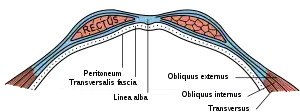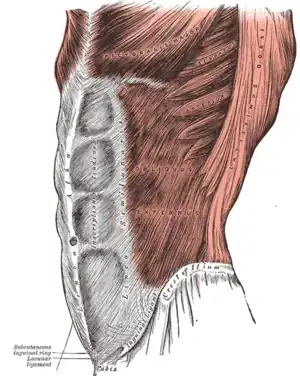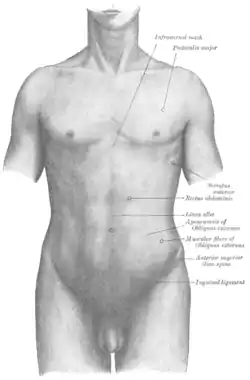Linea alba (abdomen)
| Linea alba | |
|---|---|
 Diagram of the rectus sheath. | |
 | |
| Details | |
| Identifiers | |
| Latin | Linea alba |
| TA98 | A04.5.01.022 |
| TA2 | 2377 |
| FMA | 11336 |
| Anatomical terminology | |
The linea alba (Latin: for white line) is a fibrous structure that runs down the midline of the abdomen in humans and other vertebrates.
Structure
In humans, the linea alba runs from the xiphoid process to the pubic symphysis down the midline of the abdomen. The name means white line as it is composed mostly of collagen connective tissue, which has a white appearance.
It is formed by the fusion of the aponeuroses of the muscles of the anterior abdominal wall.[1] It separates the left and right rectus abdominis muscles. In muscular individuals, its presence can be seen on the skin, forming the depression between the left and right halves of a "six pack".
Function
The Linea alba stabilizes the anterior abdominal wall, as it balances contractile forces from the muscles attached to it.[1]
Clinical significance
A median incision through the linea alba is a common surgical approach for abdominal surgery. This is because it consists of mostly connective tissue, and does not contain any primary nerves or blood vessels.
Additional images
 Surface anatomy of the front of the thorax and abdomen.
Surface anatomy of the front of the thorax and abdomen. Linea alba
Linea alba
See also
References
- 1 2 Gräβel, David; Prescher, Andreas; Fitzek, Sabine; Keyserlingk, Diedrich Graf v.; Axer, Hubertus (2005-03-01). "Anisotropy of human linea alba: A biomechanical study". Journal of Surgical Research. 124 (1): 118–125. doi:10.1016/j.jss.2004.10.010. ISSN 0022-4804.
External links
- skel&wallsabd at The Anatomy Lesson by Wesley Norman (Georgetown University)
- Anatomy photo:35:os-0108 at the SUNY Downstate Medical Center (before removing skin)
- Anatomy photo:35:06-0101 at the SUNY Downstate Medical Center (after removing skin)
- "Anatomy diagram: 03281.000-2". Roche Lexicon - illustrated navigator. Elsevier. Archived from the original on 2014-01-01.